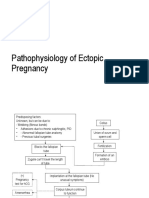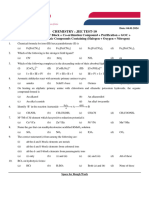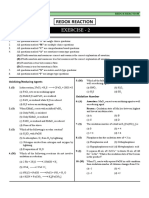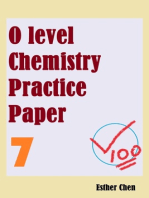Practice Paper-1: Section:1
Practice Paper-1: Section:1
Uploaded by
Shrihari ACopyright:
Available Formats
Practice Paper-1: Section:1
Practice Paper-1: Section:1
Uploaded by
Shrihari AOriginal Description:
Original Title
Copyright
Available Formats
Share this document
Did you find this document useful?
Is this content inappropriate?
Copyright:
Available Formats
Practice Paper-1: Section:1
Practice Paper-1: Section:1
Uploaded by
Shrihari ACopyright:
Available Formats
Practice Paper-1
(c) square planar with dsp-hybridisation
SECTION:1 8.
(d) trigonal bipyramidal with sp'd hybridisation
Which of the following is linear?
Strraight Objective Type Questions (a) XeF2 O(b) XeF4
This section contains 10 multiple choice questions. Each
(c) SO2 D(d) CF
9. The atomic numbers of vanadium, chromium, manganese and
which only one
question has 4 choices (a), (b), (c) and (d). Out of iron are respectively 23, 24, 25 and 26. Which once of these
is correct. second ionisation
may be expected to have the highest
1. A B(Oxide) +CO2
energy?
B+HO C (a) V O(b) Cr
C+CO A (milky) (c) Mn O(d) Fe
10. The Correct order of magnetic moments amongst following
C+NH4CI D (gas)
complex ions is:
E
D+H0CO
E+NaCl F
(a) [MnCl41 [Fe(CN6>[CoClyl
NazCO + C02 + H20
(b)Fe(CN)> [MnCII [CoCL.
F
D, E and F are
(c) [MnCLJ >[CoCL Fe(CN)%
(a) NH3, NH,CI, NHaHCO3 (d) [FeCNs > [CoCL [MnCll
(b) NH3,. NH4HCO3. NaHCO3
(c) NHHCO3. NazCO03, NaHCO3
(d) none of the above
SECTION:2
aluminium sulphate and
2. An aqueous solution of ferrous
chrome alum is heated with excess of NaO2 and filtered. The Straight Multiple Choice Objective Type Questions
materials obtained are:
This section contains 5 multiple choice questions. Each
(a) colourless filtrate and a green residue than one may
a
question has 4 choices. Out of which one o r more
(b) a yellow filtrate and a green residuee be correct.
(c) a yellow filtrate and a brown residue
brown residue 11. Which of the following are corect?
(d) green filrate and a
a
3. The bond angle in HS is: (a) XeO3 has four o and four t bonds
in BeCl2 b) The bybridization of Xe in XeF4 is sp'd*
(a)same as that of CI-Be-Cl
occurreuce of argon is
b) greatèr than H - N - H bond angle
in NH3 C) Among the noble gases, the
c) same as C-SnCl in SnCl2 highest in the air
(d) greater than H-Se-H and less than
H-0-H
(d) Liquidhelium is used in cryogenic liquids
ions which will react with water to 12. Which of the following are correct?
4. Among O, O5 and O2
liberate OH ions along with O2 gas? (a) LiClo4> NaCIO4> KCI04(solubility inwater)
(a) Oand O O(b) O and O (b) Rbl > RbBr > RbCl> RbF (lattice energy)
c) Oand O O (d) All of these (c) BaCO3 > SrCO3> CaCO3> MgCO3 (themal stability)
5. Which one of the following is not a protonic acid?
(d) Li> Be*> Nat> Mg* (hydration energy)
(a) B(OH)3 O(b) PO(OH)3 isostructural with
(c) SO(OHHh (d) sO(OH)2 13. Which of the following species is/are
A red solid is insoluble in water. However, it becomes soluble IF? D
if some KI is added to water. Heating the red solid in a test (a) [Cu(NH;)41* O(b) XeF4
tube results in the liberation of some violet coloured fumes (c)BF4 O(d) [Ni(CN)
state at room temperature
and droplets of a metal appear on the cooler parts of the test 14. The elements which exist in liquid
tube. The red solid is: are:
(a) Hgl2 Ob) (NH)2 CrO (a) Na (b) Hg
(c) Pb04 (d) HgO (c) Br (d) K
7. The geometry of ICIh ions is 15. HO, is obtained when
dilute H,SO, reacts with
(a) trigonal with O (b) MnO2
sp -hybridisation (a) BaO2
b) tetrahedral with sp-hybridisation (c) PbO (d) Na,O2
SECTION : 3 applicable for the filing of molecular orbitals. Molecules are said
to be stable if number of clectrons in bonding molccular orbitals
are more than in the antibonding molccular orbitals. Molecular
Assertion-Reason ype Questions orbital theory can explain the nagnetic behaviour of the molecules
Each question in this section contains Assertion (A) and or ions.
Reason iR). Each question has four choices, out of which only 21. In a molecule, number of electrons in bonding molecular
one is correct. Mark your choice from the following options. orbitals are more than the electrons in the antibonding
(a) Both (A) and (R) are true and (R) is the correct explanation molecular orbitals. hence
(a) a bond will be formed
of (A).
(b) no bond will be formed
(b) Both (A) and (R) are true but (R) is not the correct
explanation of (A).
(c) information is not sufficient
(d) none of the above
(c) (A) is correct but (R) is false.
22. Molecular orbital theory is preferred over valence bond theory
(d) (A) is false but (R) is ture.
as it can explain:
16. (A) Halogens have maximum negative electron gain enthalpy (a) bond strength ( b ) geometry of molecule 0
in respective periods of the periodic table. c)magnetic nature (d) none of these
(R) Halogens have high effective nuclear charge. 23. In which set of molecules, all the species are paramagnetic?
17. (A) Between SiCl4 and CCl4, only SiCl4 reacts with water. (a) B2,O2.Na b ) B2, O2, NO
R) SiC4 is ionic while CCl4 is covalent. () B2, F2. O2 d ) B2.02. Li2
18. (A) Smaller the size of an atom greater is its electronegativity.
R) Electronegativity refers to the tendency of the atom to
share electrons with the other atom.
SECTION 5
19. (A) CaH2 is known as hydrolith.
(R) It is an ionic hydride and on hydrolysis it evolves
Matrix-Match Type Questions
hydrogen. Each question contains statements given in nwo colunns,
20. (A) All noble gases are monoatomic. which have 1o be matched.
(R) The electronic configuration of noble gases is either 24. Match List-I with List-II:
nsnp or 1s (helium). List-I List-1I
(Metal) Procedure of extraction)
SECTION: 4 (a) Iron (p) Carbon/carbon monoxide
reduction method
(b) Lead (q) Self reduction
Linked Comprehension Type Questions
This section contains a paragraph. Based upon paragraph,
(c) Copper Thermite process
(d) Chromium (s) Hydrometallurgical process
multiple choice questions have been given. Each question has 4 25. Match Column-I with Column-I:
choices. Out of which only one is correcC. Column-I Cohumn-DI
Molecular orbitals are formed by linear combination of atomic acid Monobasic acid
(a) Orthophosphorus (p)
orbitals (LCAO). Two atomic orbitals can overlap forming two (b) Sulphurous acid (q) Dibasic acid
molecular orbitals, one of which lies at lower energy called bonding (c) Sulphuric acid ) Oxidising agent
molecular orbital and other at higher energy called antibonding (d) Perchloric acid (s) Reducing agent
molecular orbitals. Pauli exclusion principle and Hund's rule are
You might also like
- Pathophysiology of Ectopic PregnancyDocument3 pagesPathophysiology of Ectopic PregnancyJulienne Sanchez-Salazar100% (2)
- TLE Hairdressing Grade 8 9 Exp. CourseDocument25 pagesTLE Hairdressing Grade 8 9 Exp. CourseMTesa Esteban100% (2)
- CHEMISTRY TEST-10 - 04.01.2024 (Test 6 + Test 7 + Test 8 + Test 9)Document4 pagesCHEMISTRY TEST-10 - 04.01.2024 (Test 6 + Test 7 + Test 8 + Test 9)hetanshwNo ratings yet
- IMF Exam PracticeDocument3 pagesIMF Exam PracticeJacob StephansNo ratings yet
- 02 Exercise5Document21 pages02 Exercise5AkashGauravNo ratings yet
- Test 34 - Redox Reactions - Middle of PyramidDocument6 pagesTest 34 - Redox Reactions - Middle of PyramidJay PatelNo ratings yet
- IOC - IRP - Home Test-1 (Without Answer) - SendDocument8 pagesIOC - IRP - Home Test-1 (Without Answer) - SendNicholas BourbakiNo ratings yet
- JeeDocument5 pagesJeeaslamahmed23071997No ratings yet
- Redox Reactions-T-5Document2 pagesRedox Reactions-T-5Soham SagaonkarNo ratings yet
- WPT Rasi Xi Che Iit Jee 04-03-24Document3 pagesWPT Rasi Xi Che Iit Jee 04-03-24pinnaacleclasses salemNo ratings yet
- Kota Worksheet Chemical BondingDocument16 pagesKota Worksheet Chemical BondingYash GargNo ratings yet
- Part - I (Chemistry) 80 Marks Section - I Single Correct Answer TypeDocument14 pagesPart - I (Chemistry) 80 Marks Section - I Single Correct Answer TyperajeshNo ratings yet
- Chem Bond AdvanceDocument9 pagesChem Bond AdvanceAmith GabburiNo ratings yet
- 50 Expected QuestionsDocument6 pages50 Expected QuestionsShadhasanNo ratings yet
- Xi Chemistry SQPDocument6 pagesXi Chemistry SQPParikshit Singh RathoreNo ratings yet
- D and F Block DPPDocument4 pagesD and F Block DPPKalyan ReddtNo ratings yet
- Prasanna Sajee D & F Block Elements: Class 12 - ChemistryDocument3 pagesPrasanna Sajee D & F Block Elements: Class 12 - ChemistryFaiz SyedNo ratings yet
- Redox Reaction - Test Cum ExerciseDocument4 pagesRedox Reaction - Test Cum ExerciseSoham SagaonkarNo ratings yet
- 5_6165636951698313985Document15 pages5_6165636951698313985sonukewat9807549427No ratings yet
- 12th Chem Full Book MCQs With Answer KeyDocument57 pages12th Chem Full Book MCQs With Answer KeyROAST SINSNo ratings yet
- KCET 2019 Question Paper ChemistryDocument7 pagesKCET 2019 Question Paper ChemistryDarshan LNo ratings yet
- Chapter (The P-Block Elements)Document14 pagesChapter (The P-Block Elements)AtulNo ratings yet
- 02 - Coordination CompoundsDocument8 pages02 - Coordination CompoundsNithin KarthikeyanNo ratings yet
- JEE MAINS (D, F-Block Elements & Coordination Compounds)Document2 pagesJEE MAINS (D, F-Block Elements & Coordination Compounds)karthikesan475No ratings yet
- Quiz-01 to 02_Coordination Compound_12th JEE AIR_IOC_NT Sir_Deepak GurjarDocument5 pagesQuiz-01 to 02_Coordination Compound_12th JEE AIR_IOC_NT Sir_Deepak Gurjarsinghankitkr636No ratings yet
- 1 Brain Storm Chemistry Med FinalDocument7 pages1 Brain Storm Chemistry Med FinalShudhanshu KumarNo ratings yet
- Chem-II Ch#5 _ 6 Mcq's Key 2024Document2 pagesChem-II Ch#5 _ 6 Mcq's Key 2024usman6969696969No ratings yet
- NTA ABHYAS I P-Block Elements I VERMA SIRDocument5 pagesNTA ABHYAS I P-Block Elements I VERMA SIRarslaan8799No ratings yet
- Self-Practice Problems: P-Block ElementsDocument9 pagesSelf-Practice Problems: P-Block ElementsPranav DhimanNo ratings yet
- Unit2 Chemical Bonding QnsDocument5 pagesUnit2 Chemical Bonding QnsArunsethupatNo ratings yet
- Redox DPPDocument2 pagesRedox DPPplatosplanetdubaiNo ratings yet
- Redox ReactionDocument4 pagesRedox Reactiondebrishibanerjee125No ratings yet
- Chemical Bonding AssignmentDocument12 pagesChemical Bonding Assignmentpivig90932No ratings yet
- Coordination Compounds-T-4Document3 pagesCoordination Compounds-T-4sharavaravindNo ratings yet
- Dec Chem 2015Document26 pagesDec Chem 2015maheshNo ratings yet
- D and F Block Elemtents MCQ PRACTICE TEST With SOLUTIONSDocument11 pagesD and F Block Elemtents MCQ PRACTICE TEST With SOLUTIONSRijul SharmaNo ratings yet
- Adobe Scan 02-Oct-2024Document15 pagesAdobe Scan 02-Oct-2024ky072430No ratings yet
- 21.coordination Compound, D & F Block Transition ElementsDocument21 pages21.coordination Compound, D & F Block Transition ElementsQwerty100% (1)
- 12th Chem Full Book MCQs With Answer KeyDocument57 pages12th Chem Full Book MCQs With Answer KeyTHE PROFESSORS'No ratings yet
- Final Chemistry Dps Greater NoidaDocument7 pagesFinal Chemistry Dps Greater Noida10 Million SubscribersNo ratings yet
- Quiz 24 StudentDocument3 pagesQuiz 24 Studentchaudharyharshit330No ratings yet
- Sheet 2 Vsepr TheoryDocument2 pagesSheet 2 Vsepr Theorykrishna17673No ratings yet
- Chemical Bonding - Quiz 01072015Document4 pagesChemical Bonding - Quiz 01072015Shan RudraNo ratings yet
- Chemical Bonding DTS-1Document2 pagesChemical Bonding DTS-1nervoussolomon3No ratings yet
- Coordination CompoundssDocument22 pagesCoordination Compoundss810037No ratings yet
- XII - Revision Sheet - 4 - ChemistryDocument2 pagesXII - Revision Sheet - 4 - ChemistryVipin VNo ratings yet
- (WWW Entrance-Exam Net) - ChemistryDocument14 pages(WWW Entrance-Exam Net) - Chemistrydola indupriyaNo ratings yet
- 9 TBU Chemistry Term 1 25 Jul 2022Document4 pages9 TBU Chemistry Term 1 25 Jul 2022Dhruv WNo ratings yet
- Co Ordination CompoundsDocument9 pagesCo Ordination CompoundsSanket PatilNo ratings yet
- Coordination CompoundsDocument27 pagesCoordination CompoundsIndranilNo ratings yet
- Single Answer Type Questions:: Li Na K RB Li Na K RB Na Li K RB Na K Li RBDocument5 pagesSingle Answer Type Questions:: Li Na K RB Li Na K RB Na Li K RB Na K Li RBsree anugraphicsNo ratings yet
- X9 MR K2 y Udriopxe Di F9 VDocument48 pagesX9 MR K2 y Udriopxe Di F9 Vpsmicky09No ratings yet
- Worksheet(MCQ)KTR D19 Oct 2024Document17 pagesWorksheet(MCQ)KTR D19 Oct 2024tulip.1538411No ratings yet
- Code: D Kcet - 2018 Test Paper With Answer Key (Held On Thursday 19 APRIL, 2018)Document5 pagesCode: D Kcet - 2018 Test Paper With Answer Key (Held On Thursday 19 APRIL, 2018)SL loneyNo ratings yet
- NSEC Previous Year Questions (2008-2016)Document14 pagesNSEC Previous Year Questions (2008-2016)Kushagra JhaNo ratings yet
- Chemical Bonding HWDocument17 pagesChemical Bonding HWAayush PawarNo ratings yet
- Cbo 5Document10 pagesCbo 5Shivang K RaghuvanshiNo ratings yet
- Sheet-9 (FTP-S & ZENITH) 13 MayDocument5 pagesSheet-9 (FTP-S & ZENITH) 13 MayAryanNo ratings yet
- Test Chemical BondingDocument3 pagesTest Chemical Bondingdevansh dewanNo ratings yet
- Kerala SET PaperDocument11 pagesKerala SET PaperMaheshNo ratings yet
- DesizingDocument7 pagesDesizingeshaniqbal100% (1)
- Comparison of Life Insurance ProductsDocument4 pagesComparison of Life Insurance ProductsPrithvi NathNo ratings yet
- Bliss Yoga Studio Final ReportDocument36 pagesBliss Yoga Studio Final ReportlikwidsixNo ratings yet
- Chemical Bonding: Vy Bui, Lalein A. PajarilloDocument10 pagesChemical Bonding: Vy Bui, Lalein A. PajarilloYuvaraj Tan Hong LeongNo ratings yet
- In My P-Patch Garden - Organic Gardening Resources and TipsDocument6 pagesIn My P-Patch Garden - Organic Gardening Resources and TipsZafiriou MavrogianniNo ratings yet
- Construction Site - Fire Safety: Best Practice GuideDocument36 pagesConstruction Site - Fire Safety: Best Practice GuideAbdulKatherNo ratings yet
- Catalogo Natural PetDocument5 pagesCatalogo Natural PetLateralus LateralusNo ratings yet
- Texapon® WW 100: General CharacterisationDocument2 pagesTexapon® WW 100: General CharacterisationMourad EL AlamiNo ratings yet
- George Robbins Considers Himself An Aggressive Investor He S Thinking AboutDocument1 pageGeorge Robbins Considers Himself An Aggressive Investor He S Thinking AboutAmit PandeyNo ratings yet
- A Proposal On Nutrient Management On RadishDocument10 pagesA Proposal On Nutrient Management On RadishKimmy YowNo ratings yet
- Design and Development of Prosthetic LegsDocument5 pagesDesign and Development of Prosthetic LegsIJEMR JournalNo ratings yet
- CPP AcpfDocument14 pagesCPP AcpfMaria Eduarda de Oliveira Pereira CardosoNo ratings yet
- Spicy Apple Sauce Business PlanDocument23 pagesSpicy Apple Sauce Business PlanScribdTranslationsNo ratings yet
- Text Comments On Tony Jones On Mark Driscoll - What Came First, The Thug or The Theology? - NakedpastorDocument329 pagesText Comments On Tony Jones On Mark Driscoll - What Came First, The Thug or The Theology? - Nakedpastoremergent-nightmaresNo ratings yet
- JM-SOP-WS-002 FDS Tools Maintenance in Third Party FacilityDocument4 pagesJM-SOP-WS-002 FDS Tools Maintenance in Third Party Facilitymohamed.almayahi1No ratings yet
- Solutions Manual Electrons in Atoms (1760)Document9 pagesSolutions Manual Electrons in Atoms (1760)lyanNo ratings yet
- 12th HSC MH BOARD Chemistry Exercises SolutionsDocument310 pages12th HSC MH BOARD Chemistry Exercises SolutionsA-2188 Saurabh SinghNo ratings yet
- CPR 1 IR SpectraDocument2 pagesCPR 1 IR SpectrarunninkeysNo ratings yet
- Deandrea Small - Agricultural Science SBADocument8 pagesDeandrea Small - Agricultural Science SBAGODXZILLANo ratings yet
- Moo-Free Vegan ChocolatesDocument15 pagesMoo-Free Vegan ChocolatesVegan FutureNo ratings yet
- Medical Aspects of Christ CrucifixionDocument9 pagesMedical Aspects of Christ CrucifixionMonica YoussefNo ratings yet
- Confined Space Activities ChecklistDocument2 pagesConfined Space Activities ChecklistFaiz FalehNo ratings yet
- Books On AyurvedaDocument29 pagesBooks On AyurvedaVenkat Rao50% (2)
- Special Educational Needs in English Language Teaching: Towards A Framework For Continuing Professional DevelopmentDocument9 pagesSpecial Educational Needs in English Language Teaching: Towards A Framework For Continuing Professional DevelopmentjanismoreNo ratings yet
- RelyX 3D Fiber PostsDocument2 pagesRelyX 3D Fiber PostsOral Care100% (1)
- OC - PlumberDocument6 pagesOC - Plumbertakuva03No ratings yet
- Management Lessons From Mahabharata: Presentation by Kruthika.C.GDocument27 pagesManagement Lessons From Mahabharata: Presentation by Kruthika.C.GkruthikacgNo ratings yet
- (Dead On Arrival) - : DefineDocument6 pages(Dead On Arrival) - : DefineHeidi Fabillar DimaangayNo ratings yet

























































































